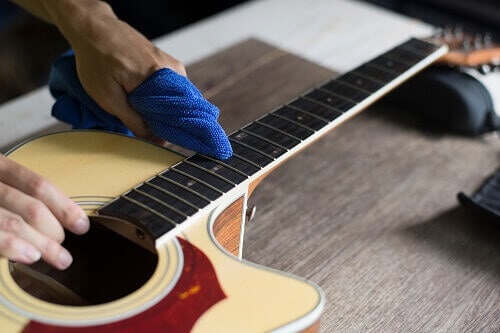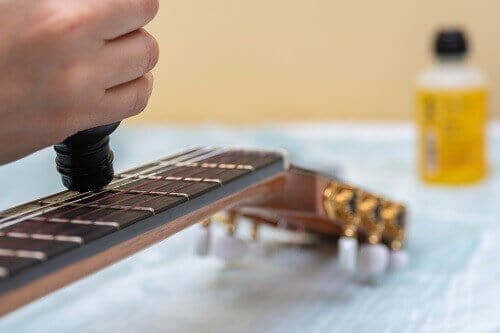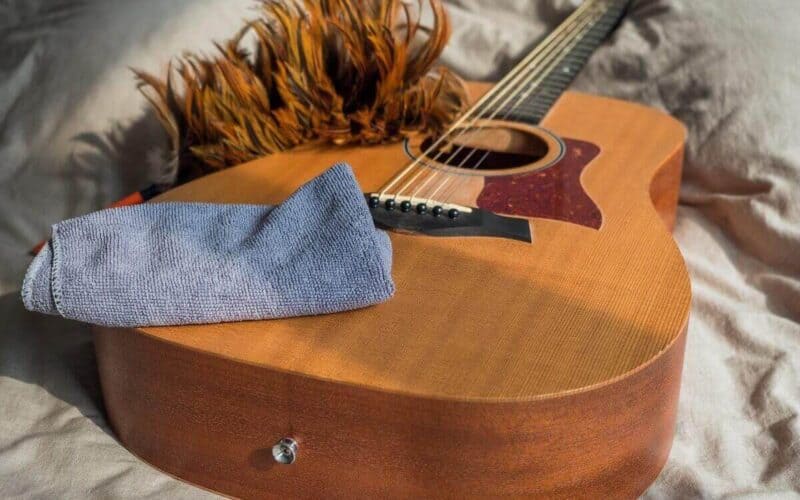Are you a guitar student or enthusiast looking to keep your acoustic guitar in top-notch condition? Caring for your instrument is vital for its longevity, and a deep clean is an essential part of its maintenance routine.
In this article, we’ll share some useful tips on how to clean an acoustic guitar that will help you keep your guitar in perfect shape. From removing grime and sweat to extending the life of your guitar, we’ve got you covered.
As a fellow guitar player hobbyist, I understand the importance of maintaining your instrument, and I’m excited to share my knowledge with you. Read on to learn how to care for your guitar and make it last for years to come.
Most Effective Ways To Clean An Acoustic Guitar
While there are many specialized guitar cleaning kits available in the market, you can also clean your acoustic guitar using common household items.
In this section, we’ll take a look at how you can clean your guitar using both items or methods. And finally, we’ll mention a few safety measures you’ll want to consider while deep cleaning your instrument to help preserve it and prolong its life.
Ways To Clean An Acoustic Guitar Fretboard
Your Guitar’s Fretboard is pretty much the essence of the whole guitar. After all, it’s where all the strings run over and where one hand always rests. So, cleaning your acoustic guitar’s fretboard is an important aspect of maintaining your instrument’s lifespan and maximizing the longevity of its strings.

Since you obviously can’t play the guitar without your fingers resting on that area, it’s a given that this area will likely require the most cleaning. All the dirt and oil that comes off your fingers will somehow make its way there and might affect its performance in the long run.
A dirty fretboard will also affect your strings and may cause their tone to deteriorate at a faster rate than normal, which will then require replacing more often.
While changing strings every 6 months or so may be called for, changing them every other month because of an oily fretboard isn’t going to be budget-friendly. Keep your guitar fretboard clean, it will maximize the lifetime of those strings!
First, you’d need to remove those strings before starting. We recommend that you also do that whenever you decide to change strings or adjust them. Now let’s take a look at some cleaning procedures you can follow.
Use Lemon Oil
For the Frets, you could start by wrapping a soft microfiber cloth around the top of the needle-nose pliers and then carefully making your way downwards, scraping each fret from the base.
As stated before, a guitar’s fretboard is the most susceptible to grease and grime build-up. To remedy that, try using a few drops of lemon oil on a soft cloth, then use it to move downwards, from the headstock, using circular motions to ensure proper cleansing.
Here we are referring to using special lemon oil products designed for guitars, which typically contain mostly mineral oil and only a small amount of real lemon oil or lemon scent and color. It is important to avoid using furniture wood cleaners. If you are interested in using lemon oil on guitar, check Bob Taylor’s view here.
But if you are interested to clean your acoustic guitar fretboard with household items, there are various ways to do so. Here are some of those household items to use:
Toothbrush
A toothbrush is a great way to get into those hard-to-reach spots on your fretboard. You can dip the toothbrush in a little bit of water (don’t get it too wet as too much moisture can harm your fretboard) to tackle the more stubborn dirt out of the fret grooves.
Dish Soap
If plain water isn’t doing the trick, a small amount of dish soap may get the job done. Use diluted dish soap (undiluted dish soap may damage the wood) to rub down the fretboard and take off the dirt.
Vinegar
If dish soap also doesn’t do the trick, vinegar surely will! Vinegar is excellent when it comes to breaking down grease. However, you should always use diluted vinegar on your guitar fretboard as it could otherwise harm the wood. Mix equal parts water and vinegar, wet a soft towel or microfiber cloth with the mixture, and wipe down your fretboard.
Q-Tips
Q-tips are just as efficient at cleaning your fretboard as they are at cleaning your ears! Lightly moisten the tip and get to work on wiping off the dirt and grime.
Extra Fine Steel Wool
Super fine steel wool (0000) is gentle enough to not leave scratches on your fretboard but tough enough to remove grime and dirt. Rub the very fine steel wool in circular motions along the frets—your fretboard should get nice and shiny in a bit.
Once you have finished cleaning your fretboard, consider applying a fretboard conditioner to keep it nourished and hydrated, which will help prevent cracking and warping in the long run.
How To Clean Acoustic Guitar Body
Cleaning the guitar’s body is slightly more complicated because of the different finishes that guitars feature. Your guitar may feature either a gloss finish, poly-finish, satin finish, or matte finish.
Most guitars feature a poly-finish (polyurethane finish). These are the easiest to clean—all you need is a damp, good-quality microfiber towel or cloth.
For a satin or matte finish, polish is an absolute “no”. You can use a little dish soap to clean guitars with these finishes if a damp cloth or microfiber towel doesn’t work. Never apply any cleaning products directly to the wood.
Use Detergents
Our main areas of concern are smudges, grease, grime, and dirt. Since these tend to affect the guitar’s lifespan, wiping them off and ensuring there is no residue is one of the most important aspects of the cleaning process.
If your guitar still has some dirt or grime on it, use a cloth sprayed with detergent and gently wipe it. Do not spray the detergent directly, though, because it can damage its wood.
Polishing
There are plenty of polish types in the market, some are oil-based or water-based and some are creamy cleaners. Make sure to use a soft microfiber or lint-free cloth while polishing.
Most acoustic guitars have a lacquer or wooden finish and using that cloth is essential because you wouldn’t want to alter any of the original resonance of your guitar.
Before you start using any kind of polish, we recommend you try it out on an unnoticeable area in your guitar to test the waters and find out whether it’s too abrasive to your guitar or not.
Clean Your Strings By String Cleaners
If you’re a hardcore player who has lots of gigs or if you play in a band and happen to use the guitar more often than not, changing your strings frequently is advised. Discolored, dirty, stiff, and dull-sounding are all signs that you need to change your strings!
However, if you happen to be a hobbyist like myself or if you’ve decided that your strings are keepers, we strongly advise you to at least clean your strings after each guitar playing session, this will ensure their longevity and performance.

There are plenty of string cleaner and lubricant brands on the market, just purchase one that matches your taste and spray a little on a clean, lint-free, or microfiber cloth. Carefully wipe the strings, not putting too much pressure on them.
This will remove all the oil, grease, and sweat from the string surface. If you happen to use coated strings, you’ll find out that they require less frequent cleaning because their protective coating helps in the long run.
Clean Guitar Strings At Home With Household Items
Here’s what you can do to clean your acoustic guitar strings at home using household items:
Boiling In Distilled Water
Boiling your strings in distilled water will help get oil and dirt out of your guitar strings. Bring a bit of distilled water to a full boil and put your strings in one by one. Let them rest there for about three or five minutes (any longer could negatively impact them).
Remove the strings with tongs and let them air dry for a full day. If you’re in a hurry, use a microfiber towel or clean cloth without lint or loose fibers, and never paper towels, as the fibers from these could get stuck to the strings.
Wipe Down with a Microfiber Towel
You can use a damp or dry microfiber towel to wipe down your strings. Rub them thoroughly to get off the grime and dirt.
Cleaning The Hardware With Household Items
Using a toothbrush, give the bridge and the soundboard a good scrub, after removing the saddle and nuts, of course.
Use the lemon oil once again to rub the bridge, using circular motions, give it some time for the wood to absorb the oil, and then carefully wipe off any excesses. Finally, use cotton swabs to clean the inside of the saddle slots and string holes.
Cleaning the pickup, pegs, and bridge can be done with Q-tips, microfiber cloth, toothbrushes, and even paintbrushes.
If there’s gunk anywhere, you can try cleaning it with water—if it’s particularly stubborn, WD-40 will help. Make sure you don’t apply the WD-40 directly to the guitar—use a towel and ensure that you wipe away any excess after cleaning.
Cleaning The Inside Of Your Guitar
Make sure to clean the insides of your guitar before restringing it. That way, it’s more convenient because the soundhole sits right underneath where the strings normally get attached.
Most people don’t clean the insides of their guitars, but dirt and dust can corrupt the sound produced by your guitar. Occasional cleaning with a dry sock, household duster, or microfiber towel/cloth should be enough to keep away the dust; if there’s a lot of dirt, a lightly dampened cloth should get the job done.
You can use a piece of dental floss to floss the area where the strings lay on the nut. It will help clean the dust from the groove.
Storing and General Information
- Store your guitar in a solid case, this will ensure that it’s away from anything potentially dangerous and damaging.
- A guitar is prone to cracking, so to ensure that it doesn’t happen, store it in a room that has consistent humidity and temperature.
- When polishing your guitar, only use guitar polish. Avoid furniture polish because it’s unsuitable for your guitar and might muffle its sound.
- Before each session, wash and sanitize your hands to prevent the grease, oils, and grime from building up on your strings and affecting your playing. Always keep a soft lint-free cloth with the guitar to wipe it down after every session.
Final Words
To wrap up the discussion on how to clean an acoustic guitar, I have to remind you that having an instrument is a responsibility. If you invested money and time into it, you must also take the time and take good and proper care of it.
Creating music is a beautiful gift, and making sure that this gift is maintained, is through wellness and the proper care for the instrument itself. Give your guitar love and care, and we guarantee you’ll be making beautiful music for life.
About the Author
Fabian, a Brazilian guitarist now based in Dublin, Ireland, has passionately played the electric guitar since 2003. As a luthier and product specialist, he boasts nearly two decades of collaboration with top musical instrument brands. Fabian is a sought-after expert, sharing his extensive knowledge with fellow guitar enthusiasts.


